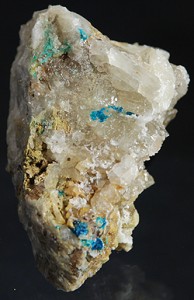Decoding Maya Colors
by Heather Pringle
August 8, 2008
          Archaeologists have long pored over the art of the Maya, studying scenes of gods, kings, and captives for clues to the beliefs and workings of this ancient Mesoamerican civilization. Now, however, researchers are taking a microscopic approach to the art—with impressive results. By analyzing rare pigments that some Maya artists applied to masks, ceramics and other artworks, archaeologists are tracking previously invisible trade-routes in the Maya world.
         Archaeologists have long pored over the art of the Maya, studying scenes of gods, kings, and captives for clues to the beliefs and workings of this ancient Mesoamerican civilization. Now, however, researchers are taking a microscopic approach to the art—with impressive results. By analyzing rare pigments that some Maya artists applied to masks, ceramics and other artworks, archaeologists are tracking previously invisible trade-routes in the Maya world.
         A fine case in point is the brilliant blue-green pigment that Maya artists applied to three jade mosaic masks recovered from 1,300-year-old royal tombs at Calakmul, one of the greatest Maya capitals. Archaeologists long assumed that the mysterious pigment came from malachite or chrysocolla, minerals that result from the weathering of copper ore. But a team of French researchers decided to look more closely, and the result of their study appears in the current issue of the scientific journal Archaeometry.
        Employing three different techniques, including particle-induced X-ray emission, the French researchers discovered to their surprise that the radiant green came from veszelyite, a rare mineral that occurs only in very small crystals in a few places in the world. Its use as a pigment “had never been reported for any civilization to our knowledge,†noted the team in its paper.  Â
        Moreover, the team determined that the blue-green mineral came from a source in the state of Puebla, southeast of present-day Mexico City.  In all likelihood, Calakmul’s powerful elite imported it from this region as a luxury good, perhaps during their dealings with rulers of the great highland city of Teotihuacan.Â
        Archaeologists elsewhere are beginning to examine other brilliant pigments in the Maya world. Researchers at the University of Arizona are studying a beautiful scarlet pigment made from cinnabar, a mercury ore originating in volcanic settings. Maya mourners once sprinkled the tombs of the royal dead with this brilliant pigment, and the Arizona team hopes to reconstruct in detail the cinnabar trade routes.
What all this is showing us is that rich exotic color has long been the stuff of luxury and longing. It’s not just today’s designers at Versace or Prada who crave such eye candy; elites in the ancient world knew and prized radiant color as well.Â
 Photo of veszelyite crystals courtesy of Excalibur Mineral Corp. Â
Comments posted here do not represent the views or policies of the Archaeological Institute of America.






 Heather Pringle is a freelance science journalist who has been writing about archaeology for more than 20 years. She is the author of Master Plan: Himmler's Scholars and the Holocaust and The Mummy Congress: Science, Obsession, and the Everlasting Dead. For more about Heather, see our
Heather Pringle is a freelance science journalist who has been writing about archaeology for more than 20 years. She is the author of Master Plan: Himmler's Scholars and the Holocaust and The Mummy Congress: Science, Obsession, and the Everlasting Dead. For more about Heather, see our 



